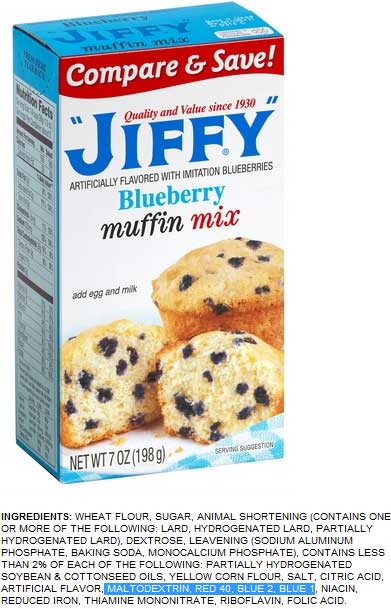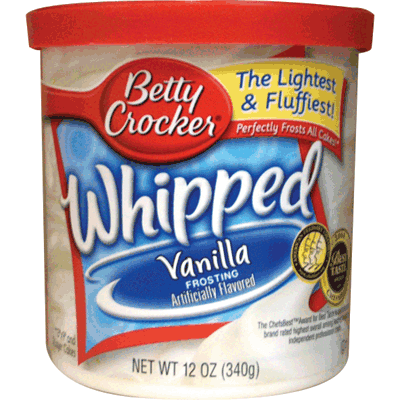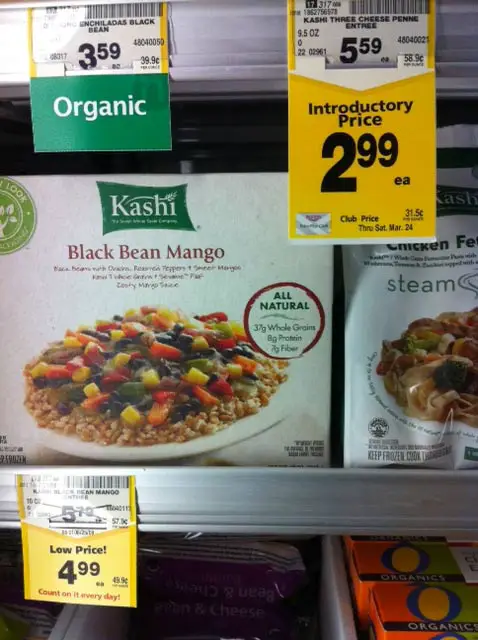 If there’s one thing I spend way too much time on in life, its the process of grocery shopping. As someone who blogs about personal finance all day long, it’s probably predictable that I waste a bunch of time obsessing over which stores qualify for the supermarket category on my American Express card. However, I also study ingredient labels because they’re more thrilling than a John Grisham murder mystery. The result? I stumble across a lot of misleading grocery products with questionable marketing on the supermarket shelf.
If there’s one thing I spend way too much time on in life, its the process of grocery shopping. As someone who blogs about personal finance all day long, it’s probably predictable that I waste a bunch of time obsessing over which stores qualify for the supermarket category on my American Express card. However, I also study ingredient labels because they’re more thrilling than a John Grisham murder mystery. The result? I stumble across a lot of misleading grocery products with questionable marketing on the supermarket shelf.
Here are some common gimmicks used by manufacturers to describe or infer whats inside their products:
Mock berries
I learned very early on in life that blueberry products were mostly made of out apple. I was in the first grade when my class toured the Jiffy Mix factory and they showed us what went into their blueberry muffin product: a lot of apples and a few blueberries.
 Today, this technique has been taken to a new level. Many “blueberry” products don’t contain any fruit at all. In fact, they’re merely using a combination of maltodextrin and food coloring to create imitation blueberries.
Today, this technique has been taken to a new level. Many “blueberry” products don’t contain any fruit at all. In fact, they’re merely using a combination of maltodextrin and food coloring to create imitation blueberries.
Some products are honest; here’s a picture of the label in its present form – at least they clearly tell us what’s inside.
On the other hand, many companies have misleading labels, such as Total Blueberry & Pomegranate cereal which, ironically, contains neither.
Worse yet, products like that typically cost more money – and people still pay because they think they’re getting something that they’re not.
Knock-off olive oil
People will also pay more when something contains olive oil. Many items will claim they contain it; unfortunately, those claims are sometimes misleading.
For starters, if you see a salad dressing or some other product which proudly brandishes olive oil on the label, you’ll often find it actually contains a blend of different oils, with canola, soybean, cottonseed, corn, or others listed before the olive.
Even if it is numero uno on the list, you can’t necessarily assume its worth it. Why? Well… because there are a lot of shenanigans going on when it comes to this coveted oil.
Imitation vanilla
Did you know real vanilla is second only to saffron among the world’s most expensive spices? As a result, many misleading grocery products actually use a vanillin that is synthetically created. Some artificial-vanilla flavors are created using coal-tar derivatives. Yuck.
 This frosting label you see at least notes that it’s artificial. But even fake vanilla can still be labeled as natural flavors or naturally flavored.
This frosting label you see at least notes that it’s artificial. But even fake vanilla can still be labeled as natural flavors or naturally flavored.
Why? Well, for a few years at the turn of this century, there was a vanilla shortage. As a result, many manufacturers that were previously using the real deal had no choice but to use the fake stuff. Yet they never changed their labeling. The FDA remained mum on this, and the industry basically interpreted that as a green light to continue doing it.
So nowadays, even with a label saying natural you still might be getting that yummy coal-tar derivative. That brings me to the next item on the list:
The word “natural”
Most of the pricey products love brandishing that word in big bold letters, but what exactly does “natural” even mean?
 Organic labeling actually has quite a few rules in the United States. In addition to the restrictions on chemicals used, organic food also can’t be genetically modified. So, for example, tomatoes crossed with fish genes cannot be marketed as USDA organic.
Organic labeling actually has quite a few rules in the United States. In addition to the restrictions on chemicals used, organic food also can’t be genetically modified. So, for example, tomatoes crossed with fish genes cannot be marketed as USDA organic.
However, “natural” is not a synonym for “organic.” The term is only regulated when it comes to meat and poultry; to be natural it can’t have artificial flavors, preservatives, or colors. It’s completely meaningless when it comes to pretty much everything else!
I could literally bottle up some gasoline and sell it to you as being natural as long as I list gasoline on the ingredient label.
Vitamin C and other nutrient additives
Manufacturers love to tell you about vitamins and antioxidants which are in their product, but are they really worth paying more for?
Practically any juice you buy will be pasteurized at temps between 145 and 280 degrees Fahrenheit to kill off any bacteria.
Unfortunately, that nutritious vitamin C from fresh fruit and vegetables is also destroyed during the pasteurization process, which is why when you buy juice that contains vitamin C, you’re actually getting it in the form of ascorbic acid, which has been added after the pasteurization.
Assuming the product is charging a premium price for having it as an additive, wouldn’t it make more sense to just buy a big tub of ascorbic acid powder for pennies per ounce instead of paying $1 more for vitamin C infused water or cereal?
The Bottom Line
You can milk your manufacturer coupons and grocery cash back cards ’til the cows come home, but that still doesn’t make you a smart grocery shopper.
I find it laughable when I see mommy coupon sites excited about a deal to save 75 cents on pomegranate cereal, or a dubious natural product, when the smarter option would be to buy a no-frills cereal that doesn’t charge extra for clusters of blue #2 and maltodextrin.
Simply put, it’s not about how much cash you save, but rather what you’re saving money on. Because paying more for misleading grocery products isn’t good personal finance, is it?
Photo Credit: Joseph Francis (cart)

Now this is scary. I don’t know if this means that we do not pay all the attention grocery shopping needs or we do not care but this is really scary.
Can I add disgusting too
The simplest option (since most of the stuff you mentioned is processed) is to cook from scratch. If you can keep a garden that’s better too. It becomes more problematic for items like meat, milk and juices, since they take up alot of space to “do your own”. For most people the best thing is to carefully read labels (as you pointed out) and do our best with what’s available.
Something I realized a long time ago is that pancake mix — the kind that requires additional ingredients by you — simply isn’t worth it.
The manufacturer supplies the cheap ingredients — flour, sugar, salt, rising agent — and you supply the most expensive ingredients — milk and eggs. And for that deal, pancake mix typically costs about 3x more than all-purpose flour.
It’s not at all hard to make pancakes from scratch. Want heartier pancakes? Use 1/2 whole wheat and 1/2 all-purpose flour, or make up your own ratio. Rinse and toss in 1 cup or so of fresh blueberries, and BING! Blueberry pancakes! No mystery lumps posing as blueberries.
Its amazing what people and companies are able to get away with. Blueberry muffins made from apple is crazy but I bet its done far to ofter and now there aren’t even apples. Natural is one of those “we fooled you words” natural doesnt mean organic but the price tag will have you thinking it did.
To me, there are basically two things people call food: food and “edible food-like substances”.
How can you tell the difference? There’s a really simple test (I should make a flow chart!):
1) Does it have a label?
if not, congrats, it’s probably food!
if so, go to step 2.
2) Can you pronounce everything on the label it?
if so, congrats, it’s probably food!
If not, then it’s probably not food.
The ideal diet is one which is 100% food. Obviously, there are a lot of factors involved: price, quality, etc. We try to eat as little of the other stuff as possible!
Dimethyl sulfide
Isoamyl acetate
Ohhh nooooo! Chemical sounding names! How scary! It can’t possibly be food!
The first drives tomato flavor, the second drives banana flavor and are naturally found in both.
What you don’t realize is those ‘things you can’t pronounce’ are already in your food, natural or not. Maybe instead of being ignorant, you learn what those scary names really mean?
Okay, fake “Blueberries” are really cheesy. But what’s with the grief for artificial vanillin, and post-process-added Vitamin C? How are they “ripoffs”?
Coal-tar derived vanillin is 100% chemically identical to the vanillin from an actual vanilla bean. The real stuff has many other flavoring compounds, but in baked goods, most of those evaporate off during heating. (There is a flavor difference in dairy products, such as ice cream.)
Ascorbic Acid is Ascorbic Acid, it doesn’t make any different to your body at all if started out as part of an orange, or was added in post-processing as part of an enrichment process. Again, how is this a “ripoff”?
As the smartest people have been telling us, shop only the outside lanes of grocery stores where the actual ingredients are. It’s those inner aisles where you are paying for test tube nutrition, added water, and the transportation cost to bring you water.
Wow, this post was as insightful as it was horrifying to me. Like most people I at least try to be health conscious and have heard of the miraculous benefits of ingredients like oil, vitamin c, and “natural” products. To know that these ingredients are misrepresented, often completely absent, in the shelf items I spend extra money on is maddening and disturbing. I suppose its the job of consumers like me to read up on the facts through articles like these before I go shopping.
I remember watching an episode of Stephen Colbert where the host pointed out how food manufacturers mislead consumers into thinking their products are milk chocolate. They call them chocolatey. How many times have you heard that? Now that I’ve mentioned it, you’ll notice this term used everywhere.
Another thing is some folks get carried away with coupons. At the end of the day, they think they saved but because of coupons, they may have spent more on items they never needed.
Wow – I practically grew up on those muffins! I agree about couponing – my opinion is that most of those items are processed junk anyway.And yes, the “all natural” thing is something to watch for! In fact there are certain allowances within the organic certification that would surprise people as well. If you’re wanting organics by local as much as possible and meet the people who grow,raise, or bake your food!
Europe has much stronger laws on advertizing to prevent this deceit.The USA consumers should campaign for this too.
Cartoseum or carsoteum, is a beaver’s anal gland juice so it is used for vanilla or raspberry flavoring. If you type the website in Google and look at the 8th or nearby thing in the article, the proof will be present.
Thanks, Jimi. Thanks for the info. After doing a bit of research, I’ve got some good news and bad news.
The good news is it appears that castoreum is NOT used to enhance vanilla flavorings. The bad news is that, nevertheless, castoreum IS approved for use as a flavor enhancer in foods and — even worse — can be surreptitiously labeled as a “natural flavor” on the product ingredient list.
http://www.vrg.org/blog/2011/06/17/beaver-gland-castoreum-not-used-in-vanilla-flavorings-according-to-manufacturers/
I was glad to read on the link that beaver “juice” is only used in perfumes. I wondered who would be brave enough to taste it!!! They say the guy who first drank milk was brave, but he had the calf as an example. I guess someone had a beaver and said… hummmm that smells like vanilla. Glad he didn’t say… let me taste it!
In order to avoid the deception practiced, wouldn’t it be easier to just skip all the processed stuff? Processed everything is bad for you anyway, you are better off without it.
We’ve changed our diet and the only processed food I buy now is dairy, condiments, and high quality chocolate.
I try to buy the higher quality dairy products, like whole milk greek yogurt instead of greek yogurt that had all the fat removed.
Barbeque sauce: source the stuff that has real ingredients, like sugar, maple syrup, vinegar etc – instead of corn syrup and fake flavorings. Ketchup – buy Heinz one that uses real sugar instead of fake stuff.
Worcestershire and soy sauce: buy the name brands that have higher quality real ingredients instead of maltodextrin.
Why don’t I make my own bbq sauce? I haven’t been able to find a recipe that we like. And most of those call for the same ingredients IN the sauce I buy such as ketchup, vinegar, sugar, spices.
It is really enticing to buy products with the term “natural,” which means that it is healthier compared with other competing products. So misleading grocery items. Thanks for sharing!
Great post. Thank you.
Great article. Love your site, Len. I just signed up to be a Len Penzo.com insider so I can access your archives!
Thanks, Leon! It’s the best $25 you’ll ever spend. 😉
You have a great memory if you can remember them telling you about blueberry muffins in the first grade (also, you must be from Michigan). I went on that same tour when I was in third or fourth grade and I don’t remember much about it. So thanks for “reminding” me about the blueberries in food. : )
I had to adopt a low-sodium diet recently and became an avid label reader. Moving toward a more basic and unprocessed diet, since nearly everything had unacceptably high salt levels, I found that raw chicken had a relatively high sodium content. Why would this be? Every brand of chicken I examined said it had 10-15% saline solution added, to increase its weight. Why is this not illegal?
Am I the only one who is old enough to remember when “natural” was a hair style?
Len, if beaver anal gland juice doesn’t lead us to lose weight, nothing will.
I never heard of a “natural” as a hair style – and I’m old. So you are officially ancient, Bill.
A natural is a black hair style.
I’m “ancient”? Now you know why Mr. Dave and I got along so well. haha